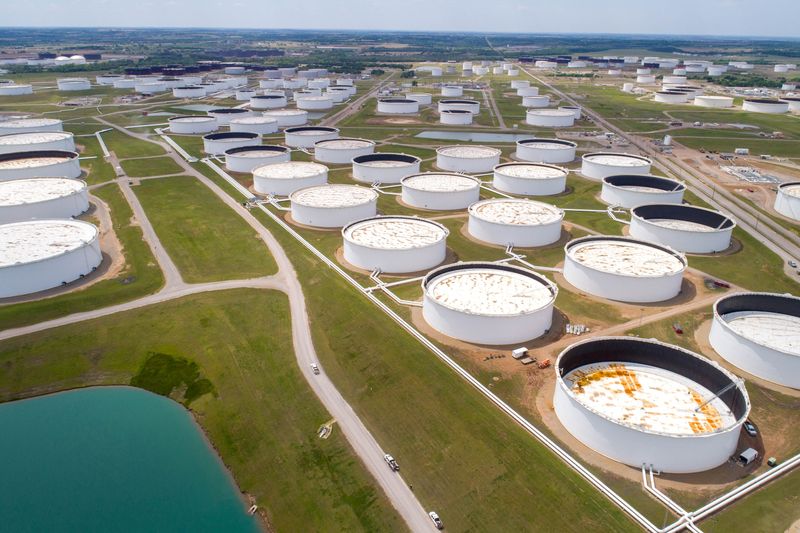Commodities
Oil prices fall, weekly 7% drop on China demand woes, mixed Mideast outlook

By Georgina McCartney
HOUSTON (Reuters) -Oil futures fell on Friday, declining more than 7% on the week after data showed China’s economic growth slowed and investors digested a mixed Middle East outlook.
futures fell $1.39, or 1.87%, to $73.06 a barrel. U.S. West Texas Intermediate crude settled at$69.22 a barrel, down $1.45 or 2.05%.
Brent settled more than 7% lower this week, while WTI lost around 8%, marking their biggest weekly declines since Sept. 2, when OPEC and the International Energy Agency cut their forecasts for global oil demand in 2024 and 2025.
In China, the world’s top oil importer, the economy grew at the slowest pace since early 2023 in the third quarter, though September consumption and industrial output beat forecasts.
“China is key to the demand side of the equation so that is very much weighing on prices here today,” said John Kilduff, partner at Again Capital in New York.
China’s refinery output declined for the sixth straight month as thin refining margins and weak fuel consumption curbed processing.
“We cannot ignore the impact of electric vehicles in China,” said Neil Atkinson, Paris-based independent energy analyst and former head of the oil division at the IEA.
“There are various factors at play here, economic weakness in China but also the move towards the electrification of transport.”
Electric vehicle sales in China jumped 42% in August and reached a record high of over one million vehicles.
Meanwhile, China’s central bank rolled out two funding schemes that will initially pump 800 billion yuan ($112.38 billion) into the stock market through newly created monetary policy tools.
“Chinese data shows tentative signs of improvement, but recent briefings on additional economic stimulus left market participants underwhelmed,” said Rishi Rajanala, associate at Aegis Hedging.
U.S. President Joe Biden said on Friday there was an opportunity to deal with Israel and Iran in a way that potentially ends their conflict in the Middle East for a while.
“We lost additional parts of the geopolitical risk premium in the price of oil on talks of this all reaching an end point,” said Again Capital’s Kilduff.
Biden, on a visit to Berlin, also told reporters he has an understanding of how and when Israel will respond to the missile attacks by Iran, something investors continue to anxiously wait for, said Alex Hodes, analyst at energy brokerage StoneX, said in a note.
After the killing of Hamas leader Yahya Sinwar, Lebanon’s Hezbollah militant group said on Friday it was moving to a new and escalating phase as it battles Israeli troops.
This dashed hopes earlier on Friday that Sinwar’s death would speed up an end to escalating war in the Middle East.
In the U.S., crude production smashed another record last week, according to the Energy Information Administration on Thursday, as output rose by 100,000 barrels per day (bpd) in the week to Oct. 11 to 13.5 million bpd, from its previous peak of 13.4 million bpd first hit two months ago.
Helping to give prices a floor, the EIA also said oil, gasoline and distillate inventories fell last week.

And U.S. retail sales increased slightly more than expected in September, with investors still pricing in a 92% chance of a Federal Reserve rate cut in November.
“Positive U.S. economic data has helped alleviate some growth concerns, but market participants continue to monitor potential demand recovery in China following recent stimulus measures,” said Hani Abuagla, senior market analyst at XTB MENA.
Commodities
Oil prices rise; U.S. crude inventories plunge, Russia-Ukraine truce eyed
Commodities
India’s Reliance to stop buying Venezuelan oil over US tariffs, sources say
Commodities
Oil prices climb on Venezuela supply worries

 Forex3 years ago
Forex3 years agoForex Today: the dollar is gaining strength amid gloomy sentiment at the start of the Fed’s week

 Forex3 years ago
Forex3 years agoUnbiased review of Pocket Option broker

 Forex3 years ago
Forex3 years agoDollar to pound sterling exchange rate today: Pound plummeted to its lowest since 1985

 Forex3 years ago
Forex3 years agoHow is the Australian dollar doing today?

 Cryptocurrency3 years ago
Cryptocurrency3 years agoWhat happened in the crypto market – current events today

 World3 years ago
World3 years agoWhy are modern video games an art form?

 Commodities3 years ago
Commodities3 years agoCopper continues to fall in price on expectations of lower demand in China

 Economy3 years ago
Economy3 years agoCrude oil tankers double in price due to EU anti-Russian sanctions































